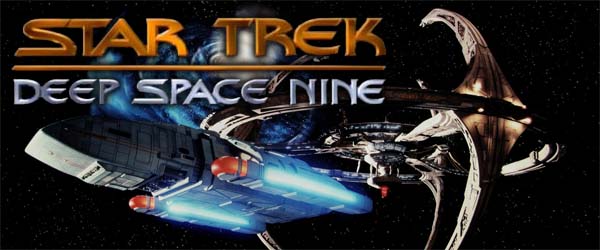
The Next Generation, Deep Space Nine, and (depending on who you talk to) Voyager are widely regarded as the "Golden Age" of Star Trek. Since many Trekkies look back at this time period of the late 80's and 90's with the rose-tinted glasses of nostalgia, it might surprise you to read that Deep Space Nine used to be a highly divisive topic among Star Trek fans. Even to this day, I've talked to "hardcore" Trek purists who dislike Deep Space Nine because of how dark and conflict-driven the series is. I can't imagine what these people must think of the Kelvin-verse reboots, Star Trek: Discovery, or Picard. If you think I'm hard on those recent iterations of Star Trek, then you should talk to these people!
In any case, the idea that DS9 is too dark and conflict-driven is a valid criticism from someone coming from the perspective of a fan of The Original Series and Next Generation. Both of those shows were about an idealistic future in which humanity had grown out of its petty squabbles and now seeks to better itself through cooperative exploration and colonization of space. Deep Space Nine didn't quite accept those ideas at face-value. Deep Space Nine's more pragmatic approach had some fans believing that Deep Space Nine violated the spirit of Star Trek.
Many fans of The Original Series and Next Generation criticized Deep Space 9 for being "too dark".
Deep Space Nine was also the first Trek series to be highly serialized, having a singular, overarching plot throughout most of the series, and with frequent mini-arcs running for half a season or a whole season. TNG had its share of recurrent story arcs. Q's "trial of humanity" was pitched as a framing mechanism for the entire show, but ended up only serving to bookend the series, while relegating most of Q's appearances each season as comic tangents. There were other recurrent sub-plots as well, such as Worf's discommendation from the Klingon Empire and his conflict with the Duras House in the "Sins of the Father" arc, the Borg story thread, Data's relationship with his brother Lore, Wesley's training as a Starfleet officer, and a few others. But TNG stayed mostly episodic. Almost all the single episodes of TNG (and the two-parters as a whole) can be enjoyed independently, without having seen any previous episodes of TNG. That was not the case with DS9.
I missed many episodes of DS9 because
it aired on weekend evenings.
DS9 was on the air throughout my elementary school and middle school years (I was seven when the show premiered). It frequently aired (syndicated on Fox in my region) on weekend evenings, and I was often outside playing tag, riding bikes, or playing touch football or street basketball with neighbor kids. As such, I missed a lot of episodes. Due to the highly-serialized nature of the show, when I would see an episode, I would have no idea what was going on! Because I rarely watched the show, and didn't understand it when I did see it, I didn't particularly like it. I'd still watch it, because it was still Star Trek. In fact, Voyager was the first Star Trek series that I watched regularly (it being on Wednesday nights, when I wasn't outside playing), and, well, you all know how I feel about Voyager.
In fact, I grew up with a bit of a preconceived notion that Deep Space Nine was the "bad" Star Trek series -- even though critics at the time largely appreciated it. On the off chance that I could talk about Star Trek with a peer, they generally didn't like DS9 either -- for many of the same reasons.
It wasn't until my college years, when the show was released for sale on DVD that I sat down and watched the whole series from start to finish. At first, I wasn't even sure if I wanted to bother buying the DVDs. After all, DS9 was "the bad Star Trek". So why spend the money? And those DVDs cost a lot of money! CBS wanted something like $120 for a single season, compared to $30 or $40 a season for shows like E.R. or Grey's Anatomy. At least the Next Gen DVDs came in fancy, sturdy boxes. The DS9 DVDs came in cheap, flimsy, rigid plastic booklets that start to fall apart as soon as you open them. I think my mom bought them from Costco for $90 a pop -- a considerable discount, but still obnoxiously expensive!
CBS wanted $120 per season for DS9 DVDs!
I was now older. I was coming to terms with my personal identity as a progressive secular humanist. Most importantly, I could finally follow along with the various multi-episode story threads and the complex, nuanced characterizations. And boy, did my opinions on the series change!
I'll always have a soft spot for Next Generation. That show has my favorite Trek character: Data. And Picard is probably my third favorite character after Spock. After my single favorite episode of Trek, the Original Series' "Balance of Terror", most of my runner-up favorite episodes are TNG episodes. Episodes like "The Measure of a Man", "Who Watches the Watchers", "The Offspring", "The Best of Both Worlds", "Deja Q", "I, Borg", "Tapestry", "The Inner Light", "Darmok", "All Good Things...", and so on...
Despite my fondness for Next Generation, I actually think that Deep Space Nine is the better all-around show.
Every Trek series since the original has taken a couple years to really find its footing. TNG doesn't really figure itself out until midway through season 2, and Voyager takes until the 4th season to figure itself out -- if ever. I don't know if Discovery ever righted its ship, since I didn't bother to watch past the first season, and Picard didn't even become watchable until the third season. I feel like DS9 finds its footing much earlier than TNG or Voyager. Deep Space Nine's characters, themes, and stories start to fall in place by the end of season 1. In fact, one of my favorite episodes of the entire series (and one of my favorite episodes of Trek in general) is a season 1 episode: "Duet". DS9 is the only Trek series (since the original) for which one of my favorite episodes comes as early as the first season.
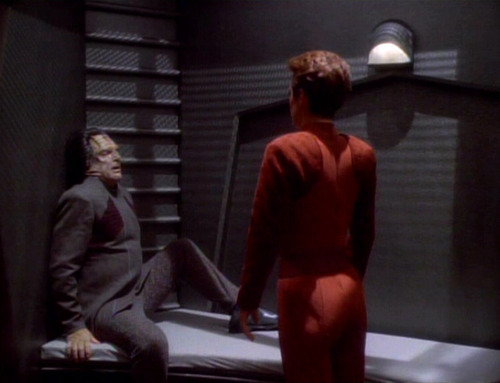 - DS9 "Duet", season 1, episode 19
- DS9 "Duet", season 1, episode 19
One of my favorite DS9 episodes (and Trek episodes in general) is the season 1 Holocaust allegory, "Duet".
The last episode of season 1, "In the Hands of the Prophets" starts to set up the season-long arcs (and a series-long arc) that would become a trademark of the series. That episode introduces us to recurring villain Vedek Winn and starts the process of her gradual accumulation of power, which I'll talk about in a future post.
But despite the series coming together better in the first season, critics of Deep Space Nine aren't wrong when they say that it "feels different" from the Original Series or Next Generation. The show is unarguably darker and more conflict-driven. The entire second half of the series is about an interstellar war, and the seasons leading up to that repeatedly tell stories about domestic terrorism, Holocaust allegories, religious persecution, and cynical politics. These sorts of themes were present in episodes of TOS and TNG here and there, but DS9, at a fundamental level, was about these difficult topics.
Different people working together
It's easy to see the frequent episodes about terrorism and genocide and slavery and write DS9 off as having disregarded the optimistic futurism of the previous two series. But I think that this does the show a disservice, and that Deep Space Nine actually works much harder than the previous series at seriously examining that future.
In the previous series, all the characters are Federation citizens and Starfleet officers. Even though the original Enterprise has a black woman, an Asian man, and a Russian on the bridge, along with an extra-terrestrial alien, they aren't really coming from different cultures and backgrounds. They are all born and raised in the Federation and indoctrinated into its ideals. The inclusion of Worf and Yar in TNG added an element of cultural differences to that series, but both were still raised within the Federation, and had bought into the Federation's principles with virtually no resistance.
- DS9 "Valiant", season 6, episode 22
Set on a space station, our heroes boldly invite new life and new civilizations to come to us.
Deep Space Nine, however, put our human characters on a space station under the sovereignty of an alien government that was not part of the Federation. They had to work alongside Bajorans, Ferengi, Cardassians, Odo, and other aliens who did not share the same morals, ethics, or ideals. For the first time in a Star Trek series, we finally see radically different people, from radically different foreign cultures, having to work together for their common good. The characters had to embrace each others' differences (or at the very least tolerate them) in an effort to work together to solve mutual problems.
Right out of the gate, this decision to set the series on a stationary outpost (as opposed to a ship that travels from planet to planet) was a brilliant idea for providing Star Trek fans with something different. Instead of our heroes "boldly going" to meet alien cultures in stale, formulaic adventures, they were boldly inviting those alien cultures to come to us. Since the station doesn't resemble a passenger cruise liner, there's also a greater sense of inviting these aliens into our homes, rather than letting them hitchhike with us for however long it's convenient. And since the station wasn't a ship that had to move onto the next planet for next week, those aliens sometimes even got to kick off their shoes and stay a while, becoming long-term guests, and sometimes even friends.
In a sense, this might very well be the fullest realization of Gene Roddenberry's original vision for Star Trek: Deep Space Nine is entirely about the spirit of benevolent cooperation, and learning to work with and accept other cultures as partners and equals. Honestly, what is more "Star Trek" than that?
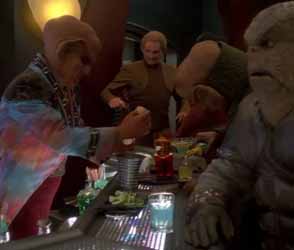 - DS9 "Valiant", season 6, episode 22
- DS9 "Valiant", season 6, episode 22
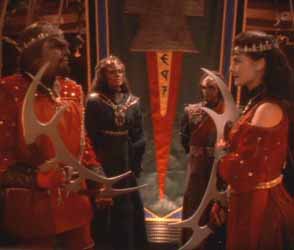 - DS9 "You Are Cordially Invited", season 6, episode 7
- DS9 "You Are Cordially Invited", season 6, episode 7
DS9 embraces racial and cultural differences even more than TOS or TNG.
Challenging the ideals of the Federation
Star Trek has always been a preachy show. It has always proudly worn its progressive values on its sleeve. That's part of why I love it.
Whereas The Original Series and Next Gen were mostly concerned with getting up on a soapbox and preaching those progressive ideals, Deep Space Nine is more concerned with the challenges of putting those ideals into practice. Deep Space Nine is a much more pragmatic show than its predecessors. Its conflicts aren't easily resolved -- if they can be resolved at all. Deep Space Nine looks back into itself and asks "Where might these ideals (as noble as they may be) start to break down?" and then asks "Can we still hold onto these ideals after they've broken down?".
Deep Space Nine takes the ideals of Star Trek (and the Federation) and it challenges them. It puts them up against complicated real-world scenarios and asks its writers and the audience if these ideals can survive the meat grinder of real life. Part of what makes the show work [for me] is that the answer is almost always "yes, these are achievable ideals worth striving for". But it's not easy, and you often have to make compromises to get there.
This is summed up nearly perfectly by a classic angry rant from Sisko about the Federation's official response to Maquis terrorism in the season 2 episode "The Maquis - Part II":
DS9 is more concerned with the challenge of putting Star Trek's ideals into actual practice.
"You know what the trouble is?
The trouble is Earth. On Earth, there is no poverty, no crime, no war.
You look out the window of Starfleet headquarters, and you see paradise. Well, it's easy to be a saint in paradise, but the Maquis do not live in paradise.
Out there in the Demilitarized Zone, all the problems haven't been solved yet. Out there, there are no saints. Just people. Angry, scared, determined people who are going to do whatever it takes to survive, whether it meets with Federation approval or not."
- Commander Benjamin Sisko, season 2, episode 21, "The Maquis - Part II"
One of the criticisms of Star Trek (in general) that you might hear is that life in the Federation is depicted as being "too easy". People have virtually unlimited resources. Everything is provided for them. They want for nothing. If they work at all, it is because they want to; not because they need to work in order to make money to make ends meet and put food on their tables. From a story-writing standpoint, this can limit the options for conflicts that the writers can create. I've heard plenty of anecdotes about cases in which writers have expressed frustrations with the limitations that Gene put on them.
From an audience's standpoint, life in the Federation can seem unrealistic -- maybe even unbelievable. Plenty of critics (especially on the conservative or regressive sides of the political spectrum), have levied complaints about the incredulity of the show's depiction of a post-scarcity economic and social structure. This is despite the fact (or perhaps in response to the fact) that some futurists and economists (see edujob) predict that this generation could see the beginnings of a post-scarcity economy by the middle of the 21st century, if our modern politicians have the political will to work towards making it a reality.
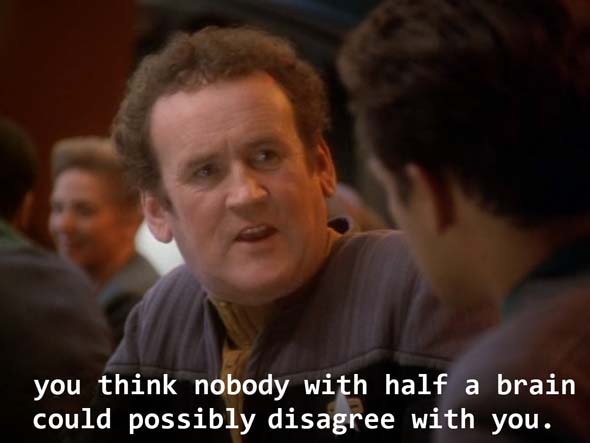 - DS9 "Statistical Probabilities", season 6, episode 9
- DS9 "Statistical Probabilities", season 6, episode 9
DS9 asks people on both sides of the political spectrum to reflect on their beliefs.
Such an economy would be fueled by a variety of factors. One is the decline in the reliance on scarce fossil fuels and minerals due to cheap and abundant green energy from nuclear fusion, solar, and wind power. Another is the possibility of automated asteroid mining to provide mineral resources and eliminating the need for environmentally-destructive mining on the Earth. The proliferation of 3-D printers and other means of self-production would reduce or eliminate our consumerist needs for massive global corporations to provide those goods and services. The growth of gig economies and personal entrepreneurship would reduce or eliminates businesses' exploitation of the workforce. The abundance of energy and materials would dramatically reduce their cost to the point that (as a simple practical matter) it's easier to distribute it to everybody than to charge individuals for access. This would create a standard of living in which even the poorest can potentially have all of their basic needs met without necessarily needing to hold full-time jobs. Any jobs that they do take would be on their (the workers') terms, and using their skills to earn extra cash to meet desires beyond their basic needs for food, water, electricity, and shelter.
In 2023, all of this looks attainable, and some of it is even starting to look familiar. It's just a matter of whether all this new productivity and resource wealth ends up belonging to the general populace, or if it is all consolidated among the already wealthy. I only hope that I live long enough to see this new economy start to take shape!
That is the world presented in Star Trek. It's a world that some people find unfathomable. Others find it morally objectionable or outright offensive, often invoking the bogeyman of "socialism".
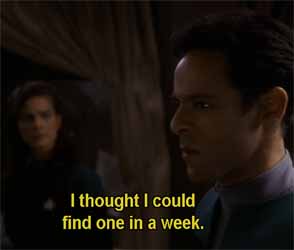 - "The Quickening", season 4, episode 24
- "The Quickening", season 4, episode 24
DS9 actively rejects the "white savior" narratives
that were prominent in TOS and TNG.
Deep Space Nine tackles that criticism head-on by providing deep, provocative, and often nuanced looks at the lives of the characters and the situations that they encounter. It contrasts the post-scarcity democratic-socialism of the Federation with the robber-baron-capitalism of the Ferengi. It contrasts the liberty of Federation governance with the totalitarianism of Cardassian martial law. It contrasts the secular humanism of the Federation with the religious fundamentalism of the Bajorans. DS9 doesn't just bring these cultures up as "aliens of the week", solve their problems, and then move on, never to see them again. It doesn't cast our heroes as the "white savior" (or at least, it doesn't lean on "white savior" narratives nearly as hard as TOS and TNG did). DS9 sticks with these cultures, immerses the audience in them, and shows us the long-term impacts of their interactions and decisions. It gives the audiences a relatively deep and nuanced look at these cultures. By the end of the series, we come to really understand Ferengi, Cardassian, and Bajoran cultures to a level on par with the Klingons.
And that's to say nothing of the way that the show provides an unprecedented look at how the peaceful Federation deals with total war.
I think we can see an excellent contrast between Deep Space Nine's story-telling philosophy, and Star Trek: Discovery's philosophy by looking at the resolution to the main conflicts of both series (well, the first season of Discovery, anyway).
Warning: MAJOR SPOILERS INCOMING FOR DS9 and season 1 of Discovery. To avoid spoilers, skip to the next section.
Deep Space Nine depicts the longest, most violent conflict that has ever been depicted in Star Trek: the Dominion War. Discovery's first season is largely about a war between the Federation and the Klingons. That war with the Klingons in Discovery ends when Starfleet operatives smuggle a weapon of mass destruction onto the Klingon homeworld Qo'nos. They threaten to destroy the homeworld (and its billions of inhabitants) and destroy the Klingon seat of government and military leadership if the Klingons do not withdraw from Federation space. It's a threat of terrorism; an ultimatum of mutual destruction. There are no shades of gray here; this is absolutely, unequivocally dark, fatalistic, and nihilistic.
- Discovery "Will You Take My Hand?", season 1, episode 15
Discovery resolves conflict through the threat of mutual annihilation.
Deep Space Nine's Dominion War, on the other hand, is resolved by 2 events. The first is the military coups on Cardassia to overthrow the totalitarian Dominion rule -- a democratic uprising by an oppressed people in an authoritarian state. This puts the Dominion on the ropes, but the final act that ends the war isn't an act of violence or a threat of destruction, it is an act of compassion. The Dominion is beaten. Starfleet could just blockade the Founder homeworld and threaten to obliterate the Great Link from orbit if the Dominion doesn't surrender. They could take the path of Discovery, but they don't. Instead, Odo and Kira offer the Founders a cure for the plague (which, to be fair, was deliberately introduced into the Great Link by Federation black ops, but that's not the point here). This is an act of mercy and a gesture of good faith in an attempt to not only end the war, but to hopefully normalize relations with the Founders and the Dominion by showing that cooperation could benefit both parties.
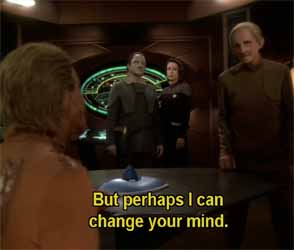 - DS9 "What We Leave Behind", season 7, episode 26
- DS9 "What We Leave Behind", season 7, episode 26
DS9 resolves conflict through
compassionate gestures of good faith.
Again, I re-iterate: the Federation has won. They do not have to offer this olive branch. In fact, by curing the Great Link, they run the risk of the Founders rebuilding the Dominion military and staging another invasion of the Alpha Quadrant in the future. But helping a defeated and suffering peoples is the right thing to do, so it is what our heroes do. They act as role models and do not stoop to the level of their enemies (or lower).
This is the subtle, but substantial difference that separates Deep Space Nine's final season from Discovery's first season. Discovery argues that conflict is resolved through force, or ultimatums, and that peace is maintained through terrorism and the threat of mutual destruction. Deep Space Nine argues that conflict should be resolved with empathy, mercy, and compassion, and that true peace can only come about through benevolent cooperation, gestures of good faith, and a recognition that both parties are stronger when they work together.
[end of spoiler]
In this way, and in many others, Deep Space Nine tackles how political realities and concessions affect those on the ground. Sisko has another great speech in the third episode of season two, titled "The Siege". Seriously, Sisko probably has just as many great speeches as Picard does! Anyway, in this episode, a political coup on Bajor forces the Starfleet personnel to abandon the station. Sisko says:
"The Federation is here at the invitation of the Bajoran provisional government. [...]
Governments can break off relations with an edict. It's not so easy when it comes down to our level, hmm?"
- Commander Benjamin Sisko, season 2, episode 2, "The Siege"
He goes on to highlight a Starfleet crew woman who is engaged to a Bajoran national, and a Starfleet father whose child worked closely with a Bajoran student on an award-winnings science project. He speaks about how everyone has made Bajoran friends and have come to care about the Bajorans as a people. And now the government has named them enemies of the state, and they must evacuate.
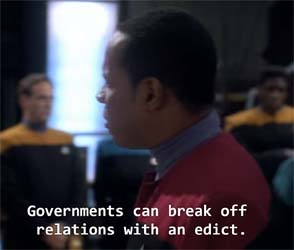 - DS9 "The Siege", season 2, episode 2
- DS9 "The Siege", season 2, episode 2
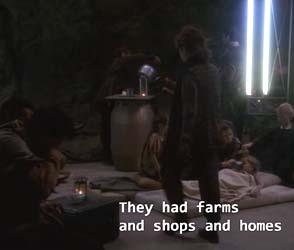 - DS9 "For The Uniform", season 5, episode 13
- DS9 "For The Uniform", season 5, episode 13
Political concessions create real hardships for the people on the ground.
This idea continues on later in the series when it starts to focus largely on the Maquis, who have been deemed "terrorists" by both the Cardassian Union and the Federation, because they have decided to fight back against Cardassian occupation after the Federation ceded territory to the Cardassians in a treaty. Next Generation had a few episodes about the Maquis as well, but the Enterprise has the benefit of being able to leave the situation behind and move on to its next mission. Being located along the Cardassian border, the crew and civilians of Deep Space Nine, however, remain targets of Maquis threats and violence and cannot simply wash their hands of the situation and move on. They have to live with the political realities and the social unrest that it causes. This leads me to my next point about the series...
- DS9 "The Visitor", season 3, episode 3
DS9 is a more complicated, nuanced series.
Shades of gray
One of my favorite things about Deep Space Nine is that its more nuanced approach to story-telling leaves a lot more shades of gray. The writers often leave the audience as the ones deciding if a character's actions were just or moral.
One great example is a season four episode called "For the Cause". In this episode, Odo and Eddington suspect Kasidy Yates (Sisko's girlfriend) of smuggling materials to the Maquis. Sisko gives Yates an opportunity to avoid being arrested, but they end up catching her red-handed. Had this been a TNG or Voyager episode, Sisko probably would have discovered that Yates had been framed, or he would have discovered some other evidence that exonerates her. Surely one of the "good guys" would not get caught smuggling goods to a terrorist organization. Right?
Nope. Kasidy is guilty. She's doing what she thinks is right, even though it's illegal, and the other characters think what she's doing is wrong. She gets arrested, and she goes to jail (not showing up in the series again until mid-way through the next season). But she isn't depicted as a villain. Her arrest causes some conflict between her and Sisko, but Sisko is willing to look past it because even he acknowledges that the Marquis situation is complicated and isn't black-and-white. Kassidy's actions are cast in a moral gray area.
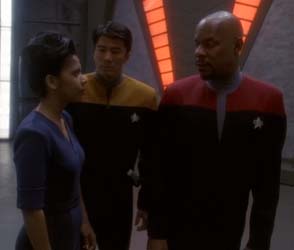 - DS9 "For The Cause", season 4, episode 21
- DS9 "For The Cause", season 4, episode 21
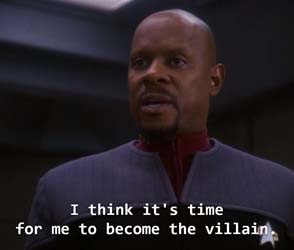 - DS9 "For The Uniform", season 5, episode 13
- DS9 "For The Uniform", season 5, episode 13
The line between "good guys" and "bad guys" isn't always razor-sharp.
You thought I was going to talk about "In The Pale Moonlight", didn't you!?
Deep Space Nine never compromises on its dedication to maintaining these shades of gray, right up through its bittersweet, teary finale.
Despite the ambiguous morals and the frequent shades of gray, the Federation continues to lead by example, shaping the moral and ethical beliefs of alien characters like Kira, Odo, Quark, and Garak. The example they set even causes Rom and Nog to mostly assimilate into Federation culture. Most importantly, however, is that the Federation officers don't assimilate Rom and Nog through force or coercion. They inspire the alien characters by respecting Rom and Nog's cultural backgrounds and setting a positive example for them to emulate. Better yet, the exchange works both ways (to some extent) with Federation characters even learning lessons from Quark, Rom, Nog, and (to some extent) Garak about alternative ways of solving problems or resolving conflicts.
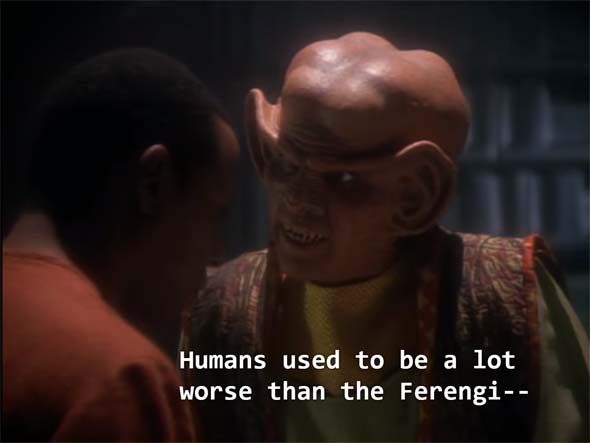 - DS9 "The Jem'Hadar", season 2, episode 26
- DS9 "The Jem'Hadar", season 2, episode 26
The human characters have moral lessons to learn from the other cultures as well.
Unlike Captain Kirk in the Original Series, the characters of Deep Space Nine aren't portrayed as "white saviors" swooping in, telling alien cultures that they're doing everything wrong, teaching the "dirty savages" how to kiss and love, and then literally blowing up the status quo, and flying off into the sunset. The characters of Deep Space Nine work hard to walk the tightrope of respecting the alien cultures, while also providing positive examples of Federation principles, and leaving the alien characters free to come to their own conclusions about which is the better way to treat people. And they respect those characters when they maintain their own cultural beliefs.
In these regards, I feel that Deep Space Nine respects the humanist ideals of Star Trek, and Gene's original vision of benevolence and cooperation, probably even moreso than the Original Series and Next Generation. And it does so by taking an honest and critical look at how those ideals and principles might work in actual practice.
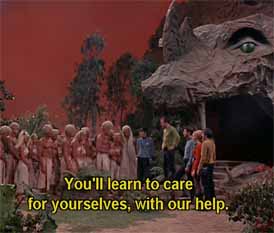 - Star Trek "The Apple", season 2, episode 5
- Star Trek "The Apple", season 2, episode 5
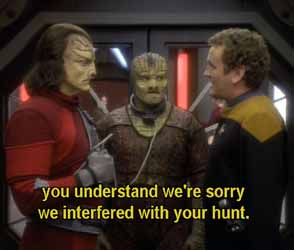 - DS9 "Captive Pursuit", season 1, episode 6
- DS9 "Captive Pursuit", season 1, episode 6
DS9's characters don't force societal reform on alien cultures.
They lead by example and let alien characters make their own decisions about how to treat each other.